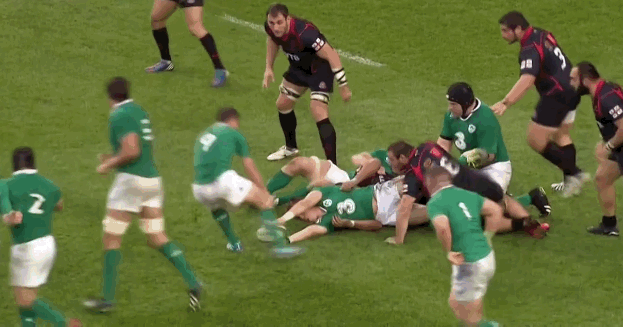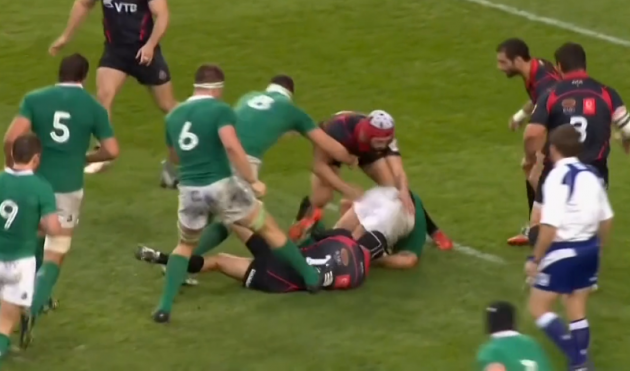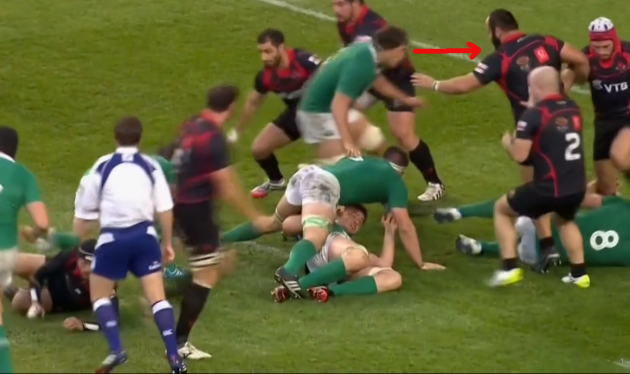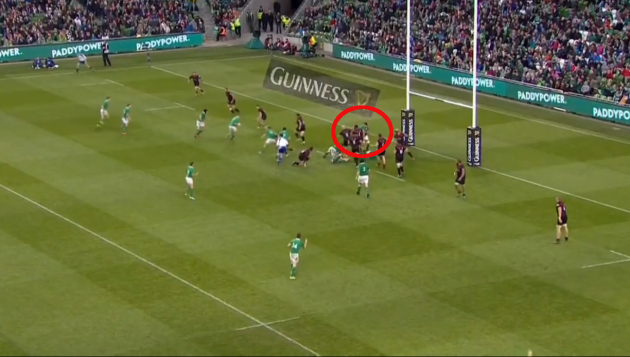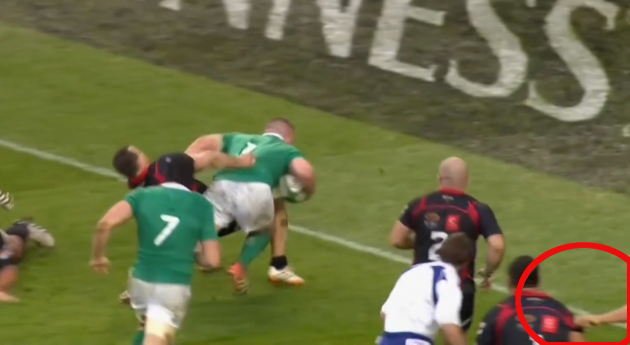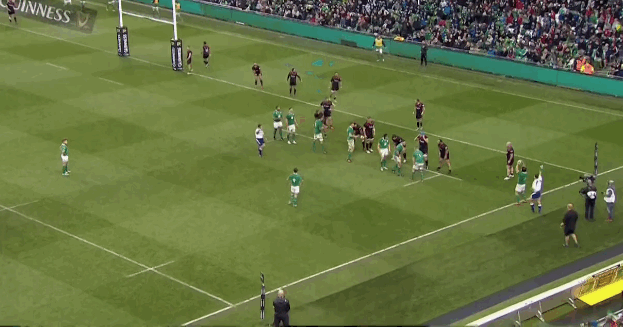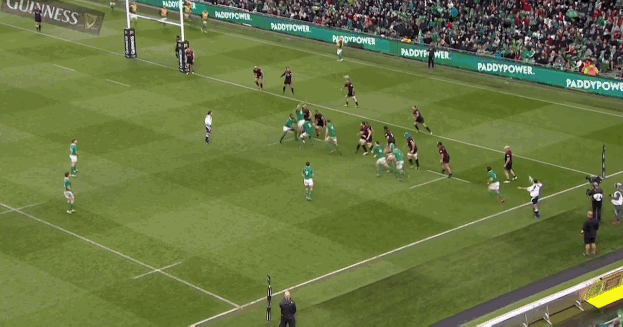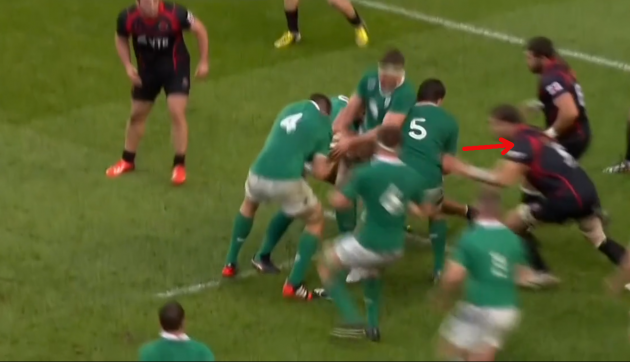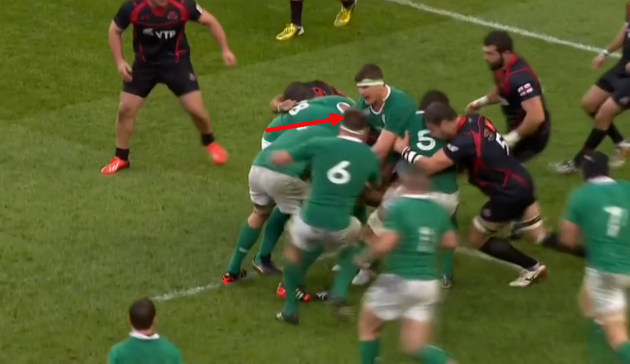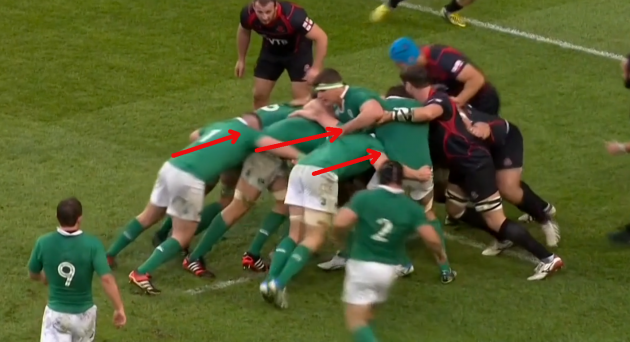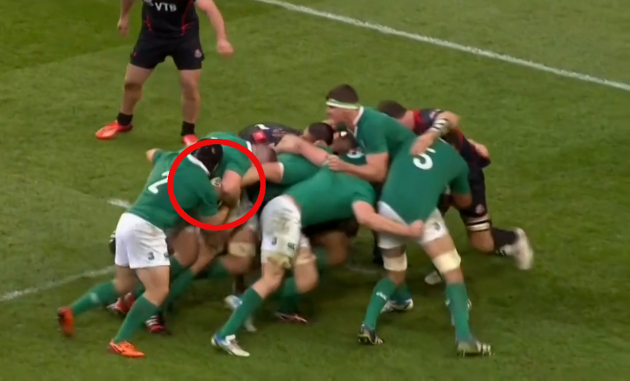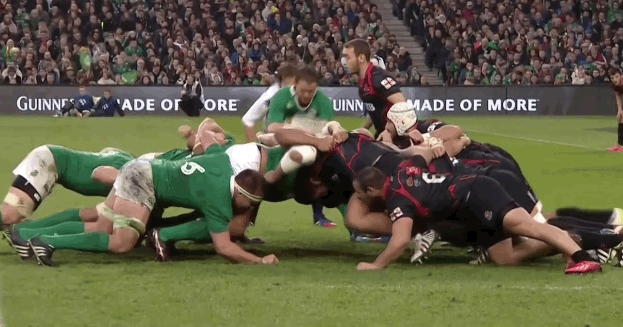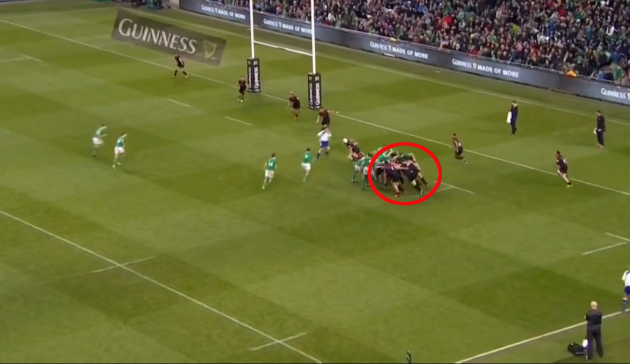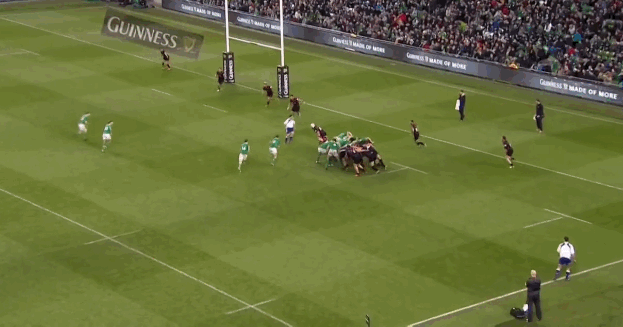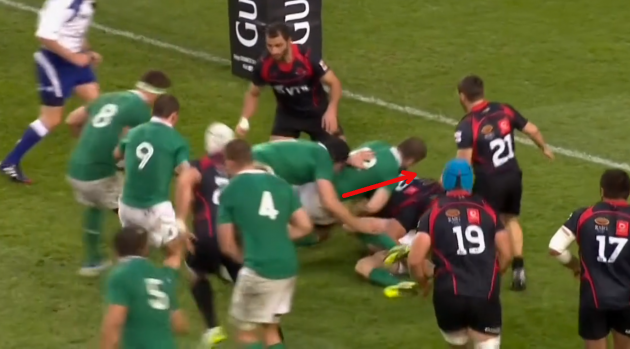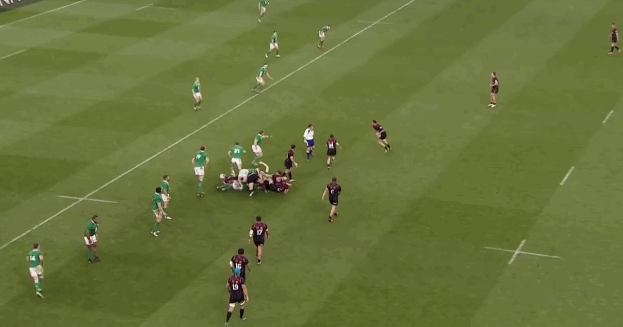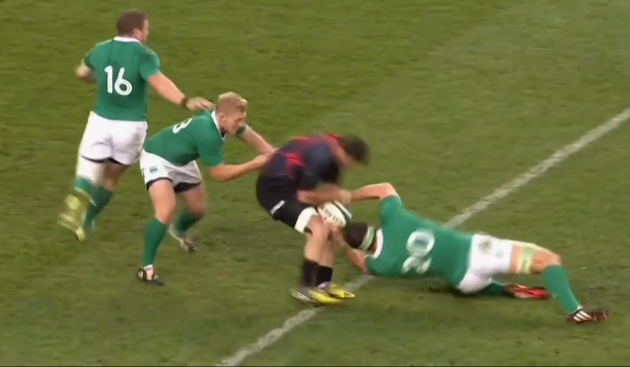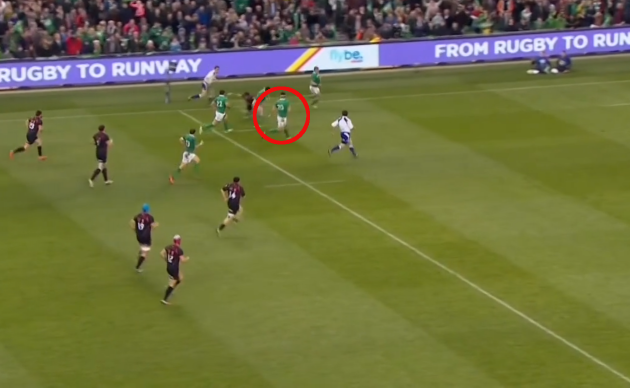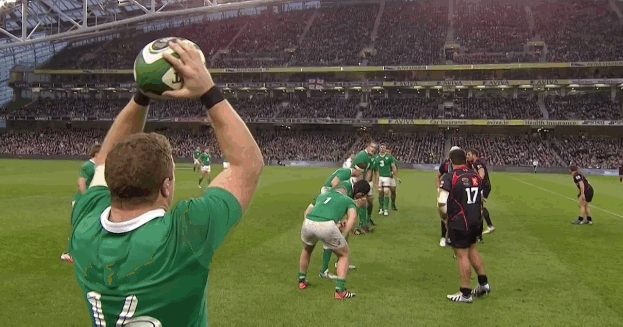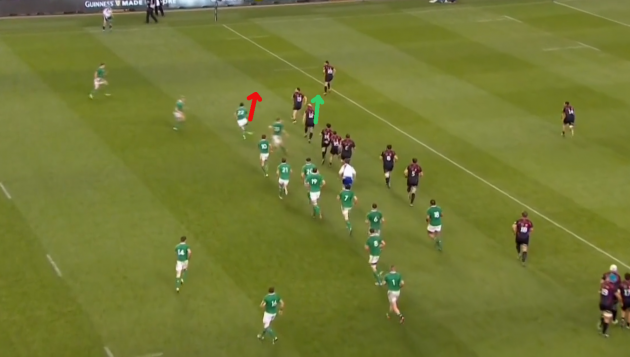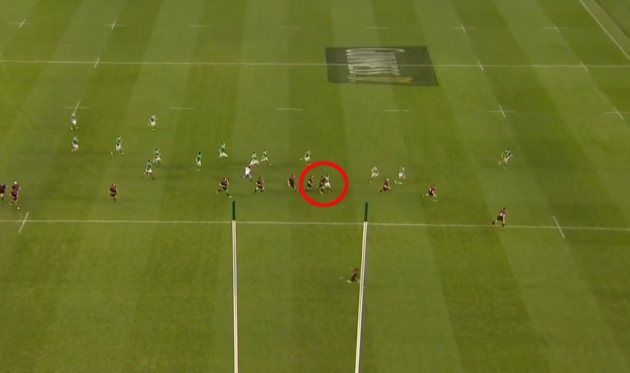“WE HAVE A saying here: ‘you try and make everyone’s job easier’. That is the goal.
“You work as hard as you can to make the fella beside you‘s job easier and that is what we all try and do. You’ve just got to buy into the system.”
Dave Kilcoyne succinctly summed up one of the key branches of Joe Schmidt’s philosophy as Ireland head coach in his post-match chat with the media following the 49-7 victory over Georgia on Sunday.
Never before have Ireland’s players been as aware of their actions in every single facet of the game. Miss your detail at ruck time and Joe will call you up. Get lazy off the ball with your support lines and Joe will spot it.
The importance of being earnest
On the flip side of that is the eagerness among the players to do the less glamourous parts of the game with as much quality as they possibly can. Clear aggressively beyond the ball after a tackle and Joe will see it. Run a clever decoy line and Joe will notice.
Schmidt and his coaching staff have drilled into their players the importance of showing intense conviction in every single one of their actions in training and games. Perfection is a pipe dream, but living towards achieving it is possible for everyone.
It’s not just about the big carries and the smashing tackles, Schmidt has highlighted how crucial things like rucking and support play are. The little actions of every player so often add up to greater things if done effectively.
With that in mind, let’s take a look at five of Ireland’s tries against Georgia and attempt to pick out a handful of those assisting actions for Irish players, the moments of quality that allowed others to get their name on the scoresheet.
Diack goes deep
One of the things that Schmidt has driven at ruck time is clearing deep beyond the ball. That is, driving the defensive player well away from where the tackle has been made and opening up the back of the ruck so Ireland have rapid possession to attack from.
Schmidt pushes excellent rucking as a way to ‘make the player beside you look good,’ allowing them to run onto quicker ball and make more yards as a result.
The majority of us might only notice the big carry, but Schmidt will look for the rucking player who helped to create the platform for it.
In the GIF above, we see Ireland’s number eight, Robbie Diack, provide a decent example.
Dave Foley does well on the ball initially, winning his collision with Georgia out-half Lasha Khmaladze and therefore allowing Ireland’s rucking players to come forward at pace.
We see below that there is a brief chance for the scrum cap-wearing Merab Sharikadze to get in on the ball and slow Ireland’s possession, but Ulsterman Diack is proactive in shutting that down immediately.
Dominic Ryan comes in to act as the guard for Ireland over the ball, meaning Mike McCarthy is essentially looking for something to do now that the quick possession is secured.
‘How can I help my team to score?’ is what Schmidt would want his lock thinking.
McCarthy gets his eyes up and spots Mikheil Nariashvili [1] attempting to fold around the corner in defence, and makes a blocking movement into the loosehead prop’s path.
Realistically, Nariashvili was probably not going to get into a strong position to have an effect on Kilcoyne diving for the line, but the point is that McCarthy is looking to have any effect on play that will help his team.
Brace for impact
Ireland’s maul has been a joy to watch in the last 12 months, first under John Plumtree and now with Simon Easterby in charge of the forwords.
We analysed the clever Rhys Ruddock maul try against South Africa last week, a hugely impressive effort that involved every single member of Ireland’s pack carrying out their role with conviction.
Ruddock got the plaudits in the stadium on that occasion, while it was Richardt Strauss who was credited in the 51st minute against Georgia. Again, Schmidt and Easterby will not have ignored the efforts of other players in making life easier for Strauss.
Ireland went close to scoring a try through their maul on a number of occasions in the first half against the Georgians, but just couldn’t go that crucial extra metre. Their half-time analysis of why that was the case was specific, and gave the Irish pack clear instructions to focus on.
We were very close in the first half,” said flanker Dominic Ryan. “We thought we should have crossed the line with one of our mauls. At half time Simon had a word with us and said ‘we’re close guys’.
“So just little things like maybe lifters weren’t strong enough, or we didn’t brace hard enough for the impact the Georgians were giving us. So we just said we’d go out with an aim to brace it up, brace the force of the Georgians better and we went over twice.”
With those instructions from Easterby in mind, watch the clip below, as McCarthy [5] braces himself against the arriving Giorgi Nemsadze and allows Ireland to set an extremely solid mauling foundation.
McCarthy’s focus has shifted into being well braced even before Diack is back on the ground. Job one [lifting] done; McCarthy turns his attention swiftly to job two [bracing].
At the back of Diack, Rodney Ah You is simultaneously making an important move after his lifting action is complete.
As highlighted below, the Connacht prop is closing off the left-hand side of the Irish maul from Viktor Kolelishvili, while also initiating the angle that Ireland will drive away to the right on.
This shift drive is a clear intention again from Ireland – draw the Georgians to a jumping pod at the back of the line-out and then rumble into the space created at the front.
Dave Foley arrives in to accept the transfer from Diack, as Kilcoyne and Tommy O’Donnell also join and provide more momentum back towards Ireland’s right-hand side.
As ever, Ireland are intent on sending the ball all the way to the tail of their maul, far from prying Georgian hands. Foley makes a second transfer back to Strauss as the maul is already rumbling towards the Georgia line, as shown below.
The combined efforts of all eight Irish forwards again lead to an excellent maul try, and at a crucial time of the game.
Ireland were 16-0 up before this Strauss score, and the Georgians would have felt they were still in contention after conceding only one try while scrum-half Giorgi Begadze was in the sin bin.
Each one of the Irish pack carried out their role effectively, making life easier for the man beside them and allowing Strauss to dot down powerfully from the tail of the maul.
Angles on the mark
So often we speak of the importance of the set-piece ‘platform,’ and in that regard, Ireland’s forwards did a fine job for Simon Zebo’s try in the 62nd minute on Sunday.
It’s important to highlight that Ireland have a numerical advantage in the scrum at this stage, with Georgia number eight Dimitri Basilaia in the bin, but that doesn’t take away from the excellent angle Easterby’s men create.
Dave Kilcoyne, and Dave Foley behind him, get a huge nudge up on the loosehead side and create exactly the ‘platform’ Ireland’s backs want in this instance. Ireland wheel all the way around to the left and exacerbate Georgia’s numerical disadvantage.
While Giorgi Chkhaidze [grey scrum cap] does well to break away from the scrum early without referee JP Doyle noticing and tackle Eoin Reddan, the rest of the Georgian pack is left in a terrible position.
In basic terms, Ireland’s forwards are closer to the ball, while the Georgians will have to come all the way around if they want to get into good defensive positions. Already a man down, that means Milton Haig’s men have major difficulty in getting around the corner on phase two and Ireland can run in untouched.
Crig Gilroy brings out his characteristic pirouette to make a crucial extra metre despite Georgia reading Ireland’s initial play, and that also means a better rucking opportunity for the supporting players.
Gordon D’Arcy is first man in, and makes an excellent contribution to clear Sharikadze away from the breakdown. The 34-year-old has long been strong in this area of the game, and gets impressively low on this occasion.
O’Donnell and Diack follow in and, again, the depth of the Irish rucking is apparent. Arguably, Diack might have been better off arriving with a little less momentum and acting as a firmer guard, but Schmidt has demanded quick ball in these situations and that’s what is in Diack’s head.
The ball from Reddan off this ruck is scrappy, but the damage has already been done by Ireland and the backs finish the chance well.
Support cast
Ireland’s fourth try, through Felix Jones, came at the end of an eight-phase attack, in which there were a whole host of important contributions outside of the assisting pass by Stuart Olding and the finish from Jones.
We turn our attention to the Jones’ second try here though, a wonderful example of clinical counter-attacking rugby. It’s not the type of try Ireland have scored too often under Schmidt, so it was certainly a welcome change from the norm.
Robin Copeland is the man to initiate the score for Ireland, as he manages to pull the ball loose from Alexander Todua’s grip. The Munster number eight lines up a high shot on the Georgian wing, expecting Olding to go low with his tackle.
Copeland gets a sense that the ball is loose and available, and grasps at it even as he goes to deck. Olding is onto it in a flash and Ireland swiftly transition from defence to attack.
If Ireland hadn’t scored from this situation, it would have been one of the great misses, but it’s still encouraging to see the chance taken so effectively. Schmidt will also have enjoyed Copeland’s supporting effort.
As Jones takes the switch pass from Sean Cronin, it’s Copeland who is on his inside shoulder, having bounced to his feet after the turnover and burst upfield in support.
Again, it’s a minor detail, but it’s something that Schmidt consistently highlights. Had Copeland not made the effort to get in support, the Ireland head coach might have asked, ‘What if Felix gets tackled here? What if he trips? What if there’s a ruck?’
Copeland’s support play will not have gone unnoticed.
Opening doors
It is worth noting that Ireland scored many of their tries when Georgia were at a numerical disadvantage. Schmidt’s men won’t have been carried away in the slightest by their win and their six tries.
That said, there is pleasure to be taken in effectively getting the job done, as for their sixth score through Stuart Olding. On the face of it, this try is all about the attacking ability of the Ulster back, but Schmidt was keen to point out the good work of others.
Stu obviously finished that try nicely,” outlined Schmidt, “he hit a nice angle. It was a set play where other guys helped Stu get the gap.
“You don’t probably put it down to one player, but the way he shaped and changed direction was pretty impressive.”
First off, the Irish line-out performs effectively, with Cronin throwing to Diack at the tail, as Ryan and Ah You lift. Kieran Marmion fires a nice pass in front of Ian Madigan, before the out-half does the same in shifting it to Ian Keatley.
All important roles, all carried out perfectly in this instance.
The switch play from Ireland’s midfield backs is then equally as effective. Darren Cave runs a dummy switch line, as Keatley burst on an outside line to open up the space for Olding.
Keatley’s short outside burst draws Sharikadze [12] onto a hard drift and opens up space inside the Georgian centre for Olding to target. As the Ireland fullback receives the switch pass from Keatley, Cave is making a crucial intervention ahead of the ball.
Despite Sharikadze being dragged wide by Keatley, we would expect that the defender inside him [Merab Kvirikashvili, 15, on this occasion] would be ‘hunting’ across in order to shut down the switch play.
As we see below, Cave runs a blocking line in front of Kvirikashvili to ensure that the Georgian gets nowhere near Olding.
It’s against the laws of the game, of course, but when done subtly enough this type of blocking is extremely difficult for the match officials to pick up. Schmidt’s men have done it very effectively over the last year.
Cave’s contribution allows Olding to burst through into a one-on-one with the covering Alexander Todua. This is where Georgia’s numerical disadvantage really tells, as Olding steps back into the space where the defensive winger would usually be trailing across.
It’s clever play all round from Ireland, as each player makes Olding’s life easier.
First-choice test
In truth, it would have been a major worry if Ireland had not enjoyed a handsome win over Georgia, but Schmidt will have been pleased to see each of his players doing the unglamorous work effectively.
His first-choice stars return on Saturday to take on Michael Cheika’s Wallabies, and there is sure to a be a far greater test of Ireland’s ability to carry out the important details with utter ruthlessness.

